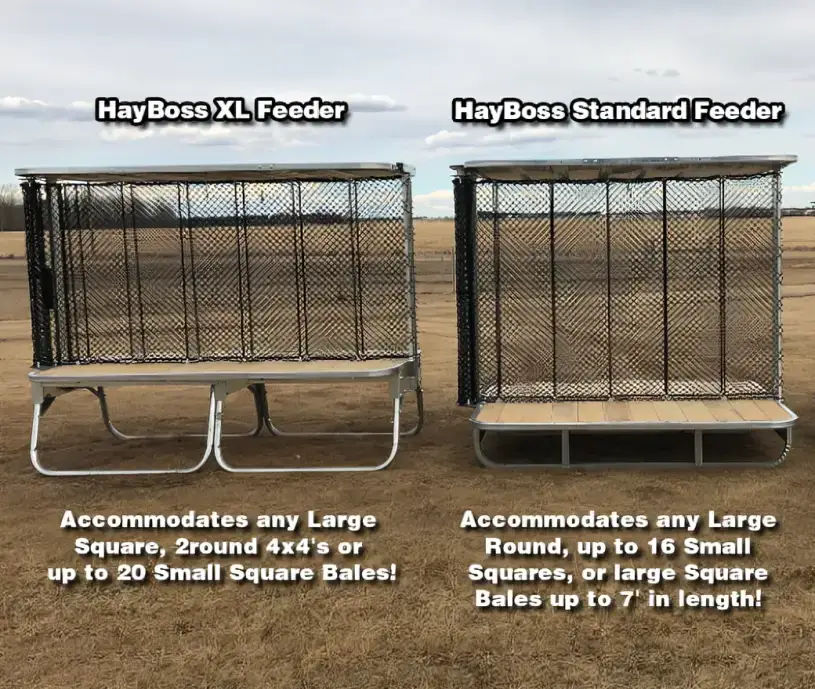Financing on Feeders also now available! Payments less than the amount of money you’ll save on Hay Costs!
Imagine this: You’ve invested in a new hay feeder, excited to make feeding time a breeze. But then reality hits – it’s either too small, requiring constant refills, or too big, leading to wasted hay.

Choosing the right size feeder can dramatically impact your livestock’s health and your bottom line.
In this guide, we’ll break down everything you need to know about hay feeder sizes. From choosing the right type to calculating the perfect capacity, we’ll help you find the ideal solution for your farm. Let’s get started.
The size of your hay feeder is a bigger deal than you might imagine. Here are four reasons why:
A hay feeder’s capacity is simply how much hay it can hold. Getting this right is crucial for efficient feeding and animal well-being. The right size ensures your animals always have hay without overfilling and wasting precious forage.
The size of your feeder directly affects your animals’ health. Too small, and they’ll compete and stress out. Too big, and hay can spoil, leading to health risks. A well-sized feeder promotes calm feeding and better overall health.
Choosing the right feeder size can save you both time and money. Less refilling means more time for other chores. Plus, preventing hay waste is like finding extra cash in your pocket.
Wasted hay is not just a financial loss; it’s a waste of resources. A properly sized feeder helps minimize spoilage, conserving your money and lowering your environmental impact.
Choosing the right hay feeder depends on your herd size, available space, and feeding preferences. Let’s explore your options:

These are built to hold entire round bales of hay. They’re great for large herds because they hold a ton of hay, meaning fewer refills. Nonetheless, they take up a lot of area and can be tough to move.
Pros: Holds large amounts of hay, reducing refills. Sturdy and durable.
Cons: Requires significant space, difficult to move.
Perfect for smaller herds, these feeders hold individual square bales. They’re easier to handle than round bale feeders but might need more frequent filling.
Pros: Easier to handle, more space-efficient.
Cons: Requires more frequent refills.
(Pro tip: If you have a large herd, then you can not go wrong with an XL feeder.)
These versatile feeders can hold hay, grain, or other feed. They’re easy to use but hay can get wasted if not designed right.
Pros: Versatile, easy to use, can hold other feeds.
Cons: Hay can be wasted if not designed correctly.
If you move your animals around, a mobile feeder is a must. They are available in a range of sizes and can be moved to different pastures. But they usually come with a higher price tag and need more maintenance.
Pros: Flexible, can be moved to different locations.
Cons: More expensive, requires maintenance.
DIY feeders offer a creative and budget-friendly option. You can design and build a feeder to meet your specific requirements and preferences. However, it’s essential to ensure the feeder is safe, sturdy, and prevents hay waste.
Pros: Cost-effective, customizable, can be made from recycled materials.
Cons: Building may require more time and effort and durability can vary.
There are other options like hanging feeders, hayring feeders, and many more! When you are choosing a feeder, consider how much hay your animals eat, how often you want to refill it, and the layout of your land.
Choosing the perfect feeder size isn’t just about guessing. It’s about finding the perfect spot for your livestock and your operation. Let’s break down the key factors:
Different animals have different appetites. Cows need more hay than goats, for instance. Understanding your livestock’s daily hay intake is crucial for choosing the right feeder size.
A larger feeder requires fewer refills, which saves you time and effort. But too big a feeder can lead to wasted hay, especially if it gets wet or moldy. Finding the right balance keeps your hay fresh and your workload manageable.
Bigger feeders often come with a higher price tag. However, they can lead to long-term savings by minimizing hay waste and reducing labor. Weigh the initial cost against potential savings to find the best value for your operation.
Getting the feeder size right is key to efficient and stress-free feeding. Here are some tips:
: Figuring out the perfect feeder size can be tricky. A good rule of thumb is to calculate how much hay your animals eat daily and choose a feeder that can hold at least that amount, plus a little extra.
: If you have a mix of animals, like cows and sheep, you might need different feeders or a versatile one that works for everyone.
: Multiple smaller feeders can help prevent fights over food and make sure everyone gets their fair share. However, one big feeder can be easy to operate.
: You should refill your feeder once every few days. The specific timing will depend on the feeder’s size and the number of animals you have.
: Sturdy materials like steel or tough plastic are your best bet. Look for something that can handle the weather and is easy to clean.
: Absolutely! A dirty or poorly designed feeder can lead to health problems. Ensure that your feeder is clean and the right size to prevent stress and disease.
Optimizing your hay-feeding system is essential for a thriving farm. By selecting the right hay feeder, you can improve animal health, reduce waste, and increase efficiency.
HayBoss is dedicated to offering innovative feeding solutions designed to streamline your daily tasks. Our feeders are designed to deliver results.
Discover the Hayboss difference. Contact us today to find the perfect feeder for your operation!
Powered by Prevail Marketing copyright 2025